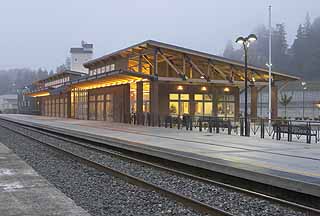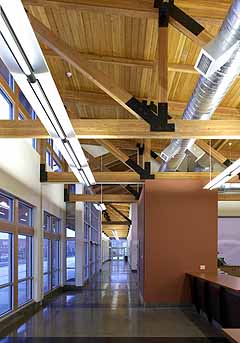|
Subscribe / Renew |
|
|
Contact Us |
|
| ► Subscribe to our Free Weekly Newsletter | |
| home | Welcome, sign in or click here to subscribe. | login |
Architecture & Engineering
| |
November 2, 2005
AIA Project of the Month: Skagit Station: All aboard for the next century
Special to the Journal

Photos by Doug Scott Photography
Skagit Station in Mount Vernon has canopies that extend over the boarding platform. The other side has a double-height masonry wall that announces the entry, along with banks of windows.
|
In the city of Mount Vernon, the Burlington Northern Santa Fe tracks pass right between the urban seat of Skagit County and the lanes of Interstate 5.
The long, narrow strip of land along the tracks next to the renovated grain elevator was once a parking lot. Now it's a train station for the next century. Skagit Station is a welcoming landmark of brick and wood stretching along the tracks.
| Skagit Station - 105 E. Kincaid St. Mount Vernon |
|
Arai Jackson Ellison Murakami Steven Arai, Bruce Ellison and Greg Ransom Owner Skagit Transit (originally owned by the city of Mount Vernon) Project type Multi-modal transportation Size 6,600 square feet Completion August 2004 Construction cost $4 million Structural engineer Quantum Engineers Electrical engineer Path Engineers Mechanical engineer Path Engineers Civil engineer Leonard, Boudinot, & Skodje Landscape architect MacLeod Reckord Transportation engineer Transportation Planning & Engineering General contractor Tiger Construction Jury comments: “The design embodies both a sense of scale and simple formal moves that reflect the program and role as public architecture.” “A simple regionally inspired structure in sympathy with Henry Klein’s work.” |
On an inside wall, a historic photograph shows a grandstand festooned with bunting, where President William Howard Taft addressed a large crowd. According to newspaper accounts from the time, Taft made this particular whistle stop an occasion to talk to the people of Mount Vernon about the First World War brewing in Europe. The train station itself is visible behind him, where the county jail now stands. The historic station was a vital link between Mount Vernon and the larger world.
In the 21st century, the train passengers are back, and so are the civic gatherings. The crowds are not quite as large as the ones in the photo, but they represent vital connections around the city and within the region.
"I always though it would be the next whistle stop location," said Skye Richendrfer, former mayor of Mount Vernon and long time promoter of the new multi-modal station.
The setting is impressive. Arai Jackson Ellison Murakami's station design brings expressive modernism together with traditional materials and structure. Masonry walls are combined with a soaring wooden roof structure.
"The brick stops at the clerestory level, allowing the roof to float," said architect Greg Ransom.
The plan of the station extends along the track, enhancing the sense of arrival for train passengers. The slope is echoed by canopies over the boarding platform and cut through by a curving roof form that marks the central spaces and dual entries to the station. On the open, east side of the station, a central brick wall rises a second story to mark the grand entry and central lobby.
Masonry walls are cut with banks of tall windows and topped with a clerestory layer that glows on foggy mornings. In the daytime, they wash the exposed structure inside with natural light.
The grandly exposed roof structure and the knee braces that rise above the brick walls set up a striking rhythm along the tracks, further elevating the importance of the station. Plazas on each end extend the plan to embrace the outdoors and provide yet more gathering places in the warmer months.
Through regional bus lines, the new multi-modal facility connects the employment centers of Mount Vernon with the larger region, and Amtrak trains connect them all in turn with larger cities. It's an increasingly popular transportation alternative to the private autos that dominate the I-5 corridor.

A long arrival corridor just inside the multi-modal station doubles as a circulation spine.
|
Surprisingly, the location of the station was the subject of long debate in the city. Plans to make it a visible and vital part of the city succeeded despite the opposition of a sizable minority, who were convinced the project should be located along the BNSF tracks near the northern edge of town, not at the center.
As mayor of Mount Vernon for two four-year terms beginning in 1995, Richendrfer made the station and its central location a priority. Revitalization was the goal, and he became an advocate for putting the station in a prominent position, where it could serve as a landmark, a source of civic pride and a venue for groups to meet or do business.
Ransom remembers a critical moment in the planning phase before a consensus was reached. He brought a model of the design, with its warm wood structure and brick walls, to a packed public meeting and clinched the deal.
According to Richendrfer, "It looked like it was meant to be there."
Funding followed. A $2 million boost in federal funding in 2002 allowed construction to begin in 2003, along with funds from Amtrak, Skagit Transit (now a resident and owner of the building) and a small percentage from the city of Mount Vernon.

Photo by Clair Enlow
Former Mount Vernon mayor Skye Richendrfer, architect Greg Ransom of Arai Jackson Ellison Murakami, and Crystil Collins of Skagit Transit at the new station.
|
The no-man's land and parking lot on the west side of the tracks is now a busy intersection of people coming and going to places all over the region.
A long, wide public corridor faces the tracks and shelters those boarding and debarking the train. The office of the Mount Vernon Chamber of Commerce is tucked into the south end of the station, just to the left of the grand entry. It can also be reached from an outdoor plaza on the end of the building. Greyhound has a window just inside to serve its buses that stop here. The local offices of Skagit Transit occupy space on the other side of the entry and grand lobby, and a generous meeting space fills the north end, opening up to the plaza just outside.
From the solid benches designed by Ransom to the kiosks inside and out, the station looks and functions like a village square as well as a rail station.
This is a place where civic dreams can grow. The meeting rooms and plaza are in high demand, according to Crystil Collins, manager of finance and administration for Skagit Transit, for community groups, business meetings and parties. In the future, the tracks may bring the "Tulip Train," a dedicated Sounder train carry visitors to Mount Vernon from Seattle during the popular Tulip Festival in the early spring.
People are using the station as a destination now, said Dennis Digges, operations supervisor for Skagit Transit.
"We have crowds here every morning," he said. Every day, commuters get off the bus and get on the train for Seattle here. In September, Whatcom Transit and Island Transit began connecting at Skagit Station, carrying 400 extra bus passengers per day back and forth to Mount Vernon, where there are offices for Puget Sound Energy and Skagit County, along with Skagit Valley College and Skagit Valley Hospital.
The station is designed to serve transit and to be accessible to pedestrians. But when it comes to numbers and visibility, the impact of Skagit Station may be greatest on I-5. This may be more strategic than ironic. For alternatives to automobile travel, there may be no better advertisement than Skagit Station.
The opposite side of the rails from Skagit Station — where the original train station once stood — is now occupied by a bulky, 1970s-era jail, with fencing. While this situation is unfortunate for the new multi-modal facility, Skagit Station now offers a foil to the forbidding stucco-finished walls across the tracks.
"When communities invest in a place of significant gathering, it matters," said Richendrfer. "This is a model of community connection and revitalization."
If Howard Taft could time travel back to Mount Vernon, he would undoubtedly be pleased.
The Project of the Month is sponsored by the Daily Journal of Commerce and the Seattle chapter of the American Institute of Architects. The project for November, Skagit Station, was selected by architect Tim Spelman, developer Bill Parks, and landscape architect Julie Parrett. For information about submitting projects contact Peter Sackett at AIA Seattle, (206) 448-4938, or psackett@aia-seattle.org.
Clair Enlow can be reached by e-mail at clair@clairenlow.com.
Previous columns:
- AIA Project of the Month: Flexible walls let gallery owners move the art, 10-05-2005
- AIA Project of the Month: 1310 Union: modern steel in a brick world, 09-14-2005
- Project of the Month: Olympic College steps to the next level, 08-03-2005
- AIA Project of the Month: 911 center: building a sense of protective calm, 07-06-2005
- Project of the Month: A peaceful retreat, just minutes from I-5, 06-01-2005
- Project of the Month: Bainbridge museum hides in plain sight, 05-04-2005
- AIA Project of the Month -- New courthouse: secure in its openness, 04-06-2005
- AIA Project of the Month: 'Providing delight in a very ordinary box', 03-09-2005


